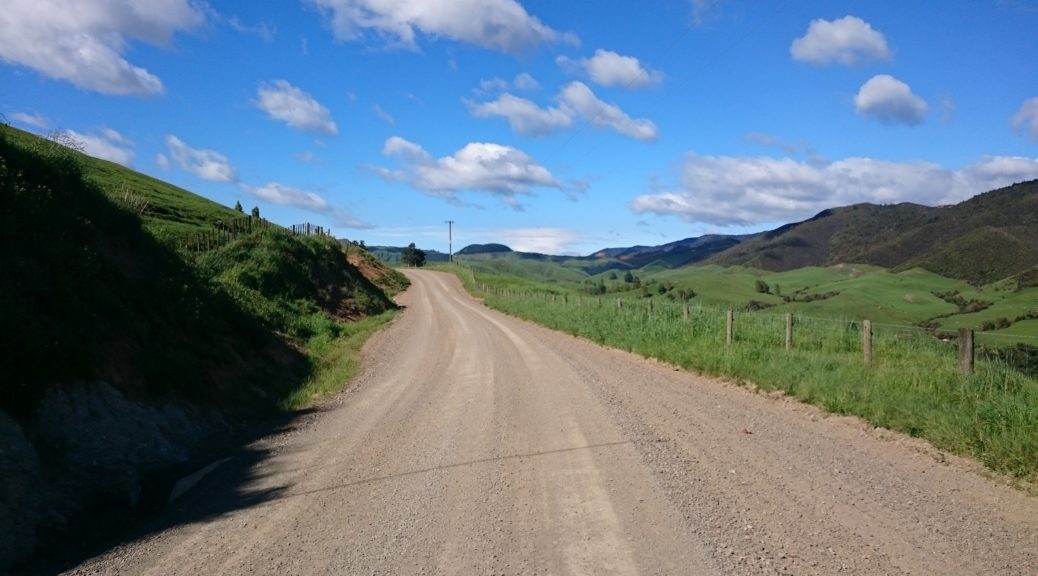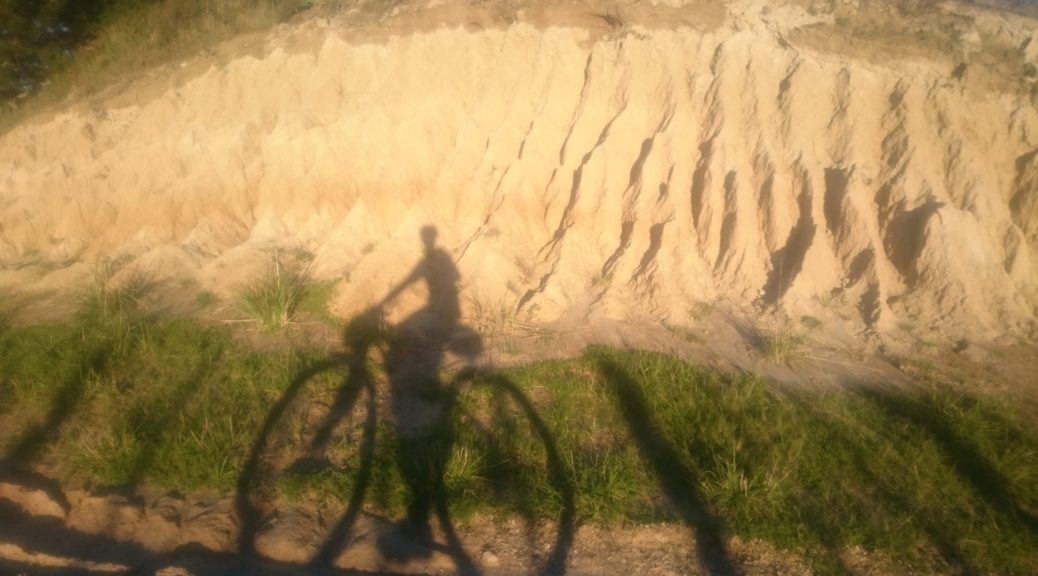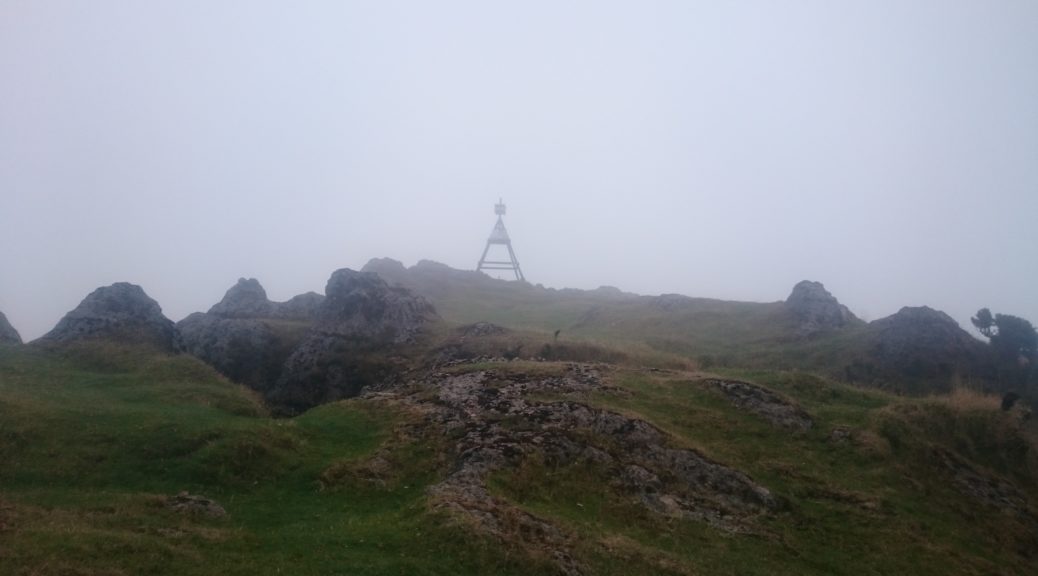Waipukurau. Saturday. One o’clock.
That’s where Carl had to be to meet his family returning from Palmerston North. Why drive when you can ride a bike and camp at the beach overnight? A plan was hatched during the week to enable this and get some bikepacking, not to mention training for Tour Aotearoa for Carl, in. I managed to sort-of work in a paper road I’d wanted to ride for some time into the plan.
Friday after work there was much rushing to get my bike loaded before we rendezvoused at the mouth of the Tutaekuri River. Battling a strong on-shore wind, we met and the drizzle set in. Nearing six o’clock, would we have enough time to ride with loaded bikes the forty kilometres over the hills to Waimarama before the pub kitchen closed? (This is becoming a theme, one I quite like – ensuring one rides efficiently and fast enough to get one’s dinner. Strong motivation.)
Familiar cycle trails were easy miles as the rain strengthened. We crossed the Red Bridge and things became less familiar – I had been on this road once before, back in July. On a grey, damp evening traffic was light; there was ample opportunity to ride side-by-side and discuss bikepacking, TA details and thankfully, little work. With only three hundred metres of climbing, it was a leisurely Friday evening ride – the rain and the summer heat making it rather muggy. Ascending the last climb, the rain had ceased and it was pleasant riding as we drew closer to that kitchen.
 At the crest of that climb, Waimarama Beach and Bare Island stretched in front of us.
At the crest of that climb, Waimarama Beach and Bare Island stretched in front of us.
Whizzing off the hill and along the flats, we made a bee-line for the pub, put our orders in and went to make camp at the local camping ground while the light held, as did the clouds. We returned to demolish our meals in one of those pubs where the patrons propping up the bar have not seen people riding into the local from a distant place, loaded with camping gear – it’s fun and amusing to be accorded astonishment and respect for such a small ride. Marveling at how achievable and great Friday-after-work bikepacking escapes are, we began plotting other possible ventures.
Rising after a sound sleep, decamping, and snacking we rolled off into a grey morning at the leisurely hour of seven o’clock. Gradually climbing up Te Apiti Road through farmland was an easy warm-up for the day. After ten kilometres we reached the end of the road and lifted our bikes over the gate onto Te Apiti Station. Checking in with the manager the day before, he’d warned Carl that it was raining and the track would be boggy. We figured we could deal with this.
It definitely wasn’t boggy. The track hardly looked wet. But we quickly found, when we couldn’t even ride up the first short, steep rise, that the innocent looking dirt track was exceptionally tacky. Rolling over it, walking over, the surface much preferred to detach itself from the earth and fasten itself to tyres and shoes. I have never experienced such vast quantities of such adhesive mud.
For two hours we tried to ride on the grass when possible; most often we couldn’t and so resorted to churning through the tackiness. This mostly consisted of pushing one’s bike until the wheels bound themselves in the frame, then dragging the bike and finally succumbing and stopping to remove vast wads of mud from, well, everything. At one stage in the middle of it all, we rode a few hundred metres and it was incredible! Just when it seemed to be getting better, we struck the worst patch yet – unfortunately this coincided with a steep, slippery ascent from which there was no escape to grass on the side. Getting ridiculous by then, we finally could look down and see a gravel farm track – it was almost over! That two hours got us a massive five and a half kilometres.
 You know it’s bad when your 2.4″ tyres turn into 4″ fat tyres; and you know it has gotten worse when the mud has bridged over the rims.
You know it’s bad when your 2.4″ tyres turn into 4″ fat tyres; and you know it has gotten worse when the mud has bridged over the rims.
 My new shoes, bought to be more comfortable for hike-a-bike, were getting a bit of walking in – but not looking so new all of a sudden. On the bright side, I did grow a couple of inches in stature.
My new shoes, bought to be more comfortable for hike-a-bike, were getting a bit of walking in – but not looking so new all of a sudden. On the bright side, I did grow a couple of inches in stature.
 Usually I have plenty of clearance between tyre and fork – not this day.
Usually I have plenty of clearance between tyre and fork – not this day.
 Nope, that wheel is not turning.
Nope, that wheel is not turning.


The countryside was ruggedly beautiful, but mostly I remember the remarkable mud. Bliss to be on a gravel road, our speed increased as we crested a couple of smaller hills before rolling down to Kairakau Beach. A small settlement of holiday homes, we tried to find somewhere to clean our bikes and shed a few kilograms of mud. Once again attracting attention for being a little mad, two dear older couples from Napier with long (five or so generations) ties to the area plied us with a large pot of tea and biscuits. And let us use their hose to wash our bikes from brown back to black. Fantastic.
Carl had somewhere to be and I had to get home as I was expecting guests. It turns out that riding out of Kairakau involves a good 250 m climb at a decent seven percent gradient. A different type of work, but preferable to making little progress through the mud. We parted ways at Elsthorpe, I stopped in at a country equestrian meet expecting a food stall of some sort – I was not disappointed. I enjoyed my first ride along the undulating Kahuranaki Road and arrived home in plenty of time after battling the same on-shore wind.
A most excellent little outing, made more memorable by being a lot more challenging than expected. As I’m starting to say more often on little adventures that don’t go quite to plan – good training for something. What something will be remains to be seen.


 I managed to cobble the requisite gear onto my bike in plenty of time – note extra water portage for the hottest day of the season so far.
I managed to cobble the requisite gear onto my bike in plenty of time – note extra water portage for the hottest day of the season so far.

 Cattle kept beady eyes on us as we climbed out of the Mohaka River valley.
Cattle kept beady eyes on us as we climbed out of the Mohaka River valley. There were plenty more hills to lay eyes on as we were pushed along by the warm northerly.
There were plenty more hills to lay eyes on as we were pushed along by the warm northerly. Carl shows me again why I really should get around to fitting some aerobars to my bike.
Carl shows me again why I really should get around to fitting some aerobars to my bike. Leaving the Mohaka far behind, we were soon back at Ball’s Clearing and whizzing down the seal back home.
Leaving the Mohaka far behind, we were soon back at Ball’s Clearing and whizzing down the seal back home.
 Leaving the Hill behind, over Westshore Bridge I followed my commute route for ten or so kilometres.
Leaving the Hill behind, over Westshore Bridge I followed my commute route for ten or so kilometres. What’s this? Offshore power boat racing. That’s different. Not to mention loud, fast and repetitive.
What’s this? Offshore power boat racing. That’s different. Not to mention loud, fast and repetitive. I was heading for the coast in the far distance, just right of centre in this shot.
I was heading for the coast in the far distance, just right of centre in this shot. The crossing of the Esk is at the start of Waipunga Rd, before the hills start. It’s looking a bit lower than a couple of weeks previous, when we had 200 mm of rain in less than forty-eight hours at work (process water at work is taken from the Esk).
The crossing of the Esk is at the start of Waipunga Rd, before the hills start. It’s looking a bit lower than a couple of weeks previous, when we had 200 mm of rain in less than forty-eight hours at work (process water at work is taken from the Esk). In the mid-afternoon sun (warming enough to only need arm warmers in addition to shirt), the climbing began – as did the views of rolling green hills and distant ranges.
In the mid-afternoon sun (warming enough to only need arm warmers in addition to shirt), the climbing began – as did the views of rolling green hills and distant ranges. The largest part of the climb ascends this ridge from right to left, steadily gaining about three hundred metres. It’s very nice.
The largest part of the climb ascends this ridge from right to left, steadily gaining about three hundred metres. It’s very nice. I really enjoyed the gradual climb – stopping often to snap photos to share.
I really enjoyed the gradual climb – stopping often to snap photos to share.

 Eventually, the road starts to roll up and down a bit more – gradually climbing overall.
Eventually, the road starts to roll up and down a bit more – gradually climbing overall. I paused at the end of Waipunga Rd to look north – this was as far north as my route would go, and also the highest altitude. I had five hundred metres to lose in the twenty kilometres to the coast.
I paused at the end of Waipunga Rd to look north – this was as far north as my route would go, and also the highest altitude. I had five hundred metres to lose in the twenty kilometres to the coast. I turned right onto Kaiwaka Rd – more lush gravel! I headed for the highway to cross it.
I turned right onto Kaiwaka Rd – more lush gravel! I headed for the highway to cross it. The sun sunk further, setting nicely on this rather out of place patch of toetoe.
The sun sunk further, setting nicely on this rather out of place patch of toetoe. More hills – thankfully I didn’t have to ride them all.
More hills – thankfully I didn’t have to ride them all.  I kept a watchful eye on my shadow as I lost altitude quickly.
I kept a watchful eye on my shadow as I lost altitude quickly. It seems one can’t really escape work – the pulpmill steaming away on the right; Napier easily visible stretching left across the water, the hills south of Havelock North in the distance.
It seems one can’t really escape work – the pulpmill steaming away on the right; Napier easily visible stretching left across the water, the hills south of Havelock North in the distance.  I said my goodbyes to cell coverage with one big downhill, a few hairpins and cool rushing air as I blasted down to Waipataki and the sea.
I said my goodbyes to cell coverage with one big downhill, a few hairpins and cool rushing air as I blasted down to Waipataki and the sea. First I had to work out how to cross the stream.
First I had to work out how to cross the stream. Big stepping stones helped, I didn’t fall in; just.
Big stepping stones helped, I didn’t fall in; just.


 It quickly became apparent that it was to be another stunning autumn day.
It quickly became apparent that it was to be another stunning autumn day. Pedaling up the driveway, the day’s only sizable hill rose in front of me.
Pedaling up the driveway, the day’s only sizable hill rose in front of me. The highway gets rather close to the coast and the puffing pulpmill comes back into view.
The highway gets rather close to the coast and the puffing pulpmill comes back into view. And just like that I was nearly home, back on my commute route.
And just like that I was nearly home, back on my commute route.
 Definitely getting closer to the clouds as we reached the summit of the road. This looks north, we turned south onto a paper road and kept climbing.
Definitely getting closer to the clouds as we reached the summit of the road. This looks north, we turned south onto a paper road and kept climbing. This view would normally look out over the Pacific in the distance. Not today. We turned onto the next paper road near that small solar panel on a pole.
This view would normally look out over the Pacific in the distance. Not today. We turned onto the next paper road near that small solar panel on a pole. We stood around and pondered for a while as to which way to go. I apparently took to riding wearing only one glove a fair bit.
We stood around and pondered for a while as to which way to go. I apparently took to riding wearing only one glove a fair bit. We were getting into the clouds further and further. Route finding became challenging, but it was decided our path continued to climb (not the track you can just see in the picture, we went up further into the clouds).
We were getting into the clouds further and further. Route finding became challenging, but it was decided our path continued to climb (not the track you can just see in the picture, we went up further into the clouds). Just as well it was worth it all for the views.
Just as well it was worth it all for the views. We saw hints of the ridge and the bluffs.
We saw hints of the ridge and the bluffs. Here we pass our first fallen tree….
Here we pass our first fallen tree…. Still we climbed through the murk; this road is definitely only on paper.
Still we climbed through the murk; this road is definitely only on paper. Shaun finds the route.
Shaun finds the route. Ignoring the peril, I’m still managing to lift my bike here.
Ignoring the peril, I’m still managing to lift my bike here. That’s a lot closer than it was!
That’s a lot closer than it was! The transmitter tower, looking rather spooky in all that cloud.
The transmitter tower, looking rather spooky in all that cloud. Our only mechanical of the trip – not entirely helpful, but it was quickly repaired!
Our only mechanical of the trip – not entirely helpful, but it was quickly repaired! Out of the clouds. Just.
Out of the clouds. Just. Which meant we had to push up that hill in the centre of the picture, just to the right of the pines. That was after avoiding a large bull that had quite a stare on it.
Which meant we had to push up that hill in the centre of the picture, just to the right of the pines. That was after avoiding a large bull that had quite a stare on it. I pottered over a stream on the farm before making it not very far up the hill – there was a lot of pushing to the top of that ridge.
I pottered over a stream on the farm before making it not very far up the hill – there was a lot of pushing to the top of that ridge. Only a couple of twenty metre cliffs between where we stood and the field on the other side – where we wanted to go.
Only a couple of twenty metre cliffs between where we stood and the field on the other side – where we wanted to go. The Mangaone River was quite nice; a packraft would have been nicer.
The Mangaone River was quite nice; a packraft would have been nicer.